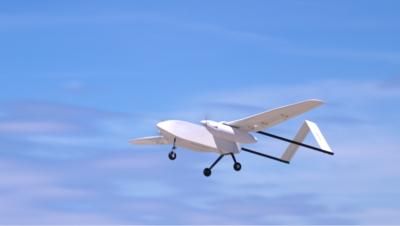Fri, Nov 25, 2022
Self-Contained Hydrogen Engine Nacelle May Be Offered as UAV Aftermarket Modification
H3 Dynamics' twin-engine hydrogen UAV demonstrator completed its first successful test flight over a Paris airfield.

The flight was a capstone of sorts, for a program that first completed a working propulsion nacelle prototype a year prior. By July, H3 Dynamics had been able to test their first distributed pod system on a scale aircraft at the Hub Drones - Systematic airfield near Paris, France. That proved the basic functionality of their hydrogen-powered system, allowing them to begin scaling up their designs. The most recent test evaluated the performance of a twin-engine, hydrogen powered, propeller-driven propulsion aircraft on the way towards larger, more complex installations. While H3 Dynamics will need to continue their progress flying small, uncrewed aircraft, the company eagerly looks to the future, with plans for bigger and better hydrogen aircraft converted from existing makes and models. With the successful demonstration of a twin-engine platform, the company says it will soon tackle a 6-engine aircraft in the same vein.
The uncrewed twin-engine test aircraft boasts a 900 km range on liquid hydrogen, stored entirely in its wing-mounted nacelles. That external mounting allows for safer, less anxiety-inducing carriage of super-flammable hydrogen fuel in addition to maximizing interior cargo storage. Should the demonstrator be powered with pressurized hydrogen, its range drops to 350 km, still quite passable given the aircraft's 30-liter interior volume. H3 Dynamics sees their standalone hydrogen nacelle design as a perfect candidate for aftermarket installation and retrofitment, an easy way to bolster the power of any small aircraft with sustainable, on-demand thrust. The compact size should mean the self-contained hydrogen nacelles can quickly be developed into a snap-on addition to existing eVTOL or fixed wing cargo drones.
“Not only is safety our first priority, but we don’t want hydrogen competing for revenue-generating air freight and passenger space,” said Taras Wankewycz, CEO of H3 Dynamics. As outlined by the company's hydrogen developers, distribution of hydrogen power is key. Spreading the hydrogen propulsion systems allows for more efficient thermal management, increased redundancy, and simpler installation.
H3 Dynamics made mention of their plan to complete an Atlantic crossing on hydrogen-electric hybrid propulsion in the next 2 years, proving the feasibility of liquid h2 power with partner ISAE-SUPAERO.
More News
Circle To Runway (Runway Number) Used by ATC to inform the pilot that he/she must circle to land because the runway in use is other than the runway aligned with the instrument appr>[...]
Aero Linx: National Aviation Safety Foundation (NASF) The National Aviation Safety Foundation is a support group whose objective is to enhance aviation safety through educational p>[...]
At Altitude Of About 250-300 Ft Agl, The Airplane Experienced A Total Loss Of Engine Power On November 6, 2024, at 1600 central standard time, a De Havilland DHC-1, N420TD, was inv>[...]
From 2009 (YouTube Edition): Three Hour Flight Was 'Flawless' -- At Least, Until Mother Nature Intervened For anyone who loves the aviation business, this was a VERY good day. Afte>[...]
Also: AMA Names Tyler Dobbs, More Falcon 9 Ops, Firefly Launch Unsuccessful, Autonomous F-16s The Air Force has begun ground testing a future uncrewed jet design in a milestone tow>[...]
 ANN's Daily Aero-Term (05.05.25): Circle To Runway (Runway Number)
ANN's Daily Aero-Term (05.05.25): Circle To Runway (Runway Number) ANN's Daily Aero-Linx (05.05.25)
ANN's Daily Aero-Linx (05.05.25) NTSB Prelim: De Havilland DHC-1
NTSB Prelim: De Havilland DHC-1 Classic Aero-TV: The Boeing Dreamliner -- Historic First Flight Coverage
Classic Aero-TV: The Boeing Dreamliner -- Historic First Flight Coverage Airborne-NextGen 05.06.25: AF Uncrewed Fighters, Drones v Planes, Joby Crew Test
Airborne-NextGen 05.06.25: AF Uncrewed Fighters, Drones v Planes, Joby Crew Test



